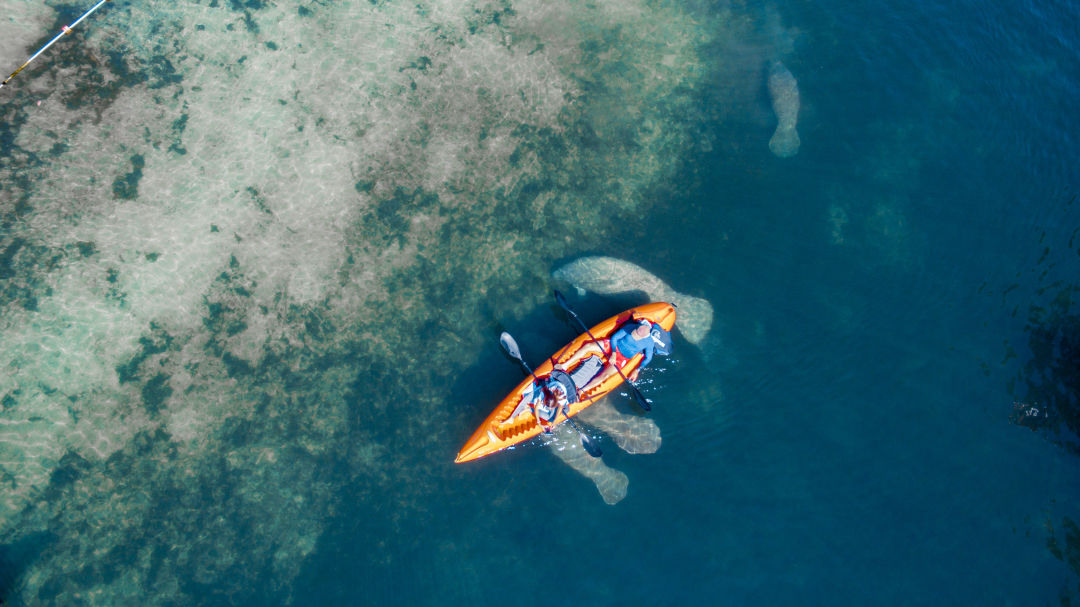Sarasota's Waterways Are Filled With Vibrant Wildlife

You'll often spot manatees in our area's waters.
Image: Shutterstock
Humans aren’t the only ones who enjoy Sarasota’s world-class beaches. The soft sand, warm waters and sunny weather are an ideal environment for a wide variety of marine species. Here’s a look at some of the wildlife found in the Gulf—and a few best practices if you have an aquatic encounter of your own.
Allison Vilardi, self-described local “fish nerd” and staff instructor at Florida Underwater Sports, says she’s counted approximately 90 varieties of fish in the Sarasota area. “The biodiversity found off Sarasota’s beaches is astounding,” she enthuses. “Even an experienced Sarasotan can still find unfamiliar fish swimming across their path. From seahorses to sharks to Goliath groupers, Sarasota’s got it all.”
Vilardi has several suggestions for local snorkeling or swimming sites, including Point of Rocks at south Siesta Key, the Lido Key Beach jetty, the south end of Overlook Park on Longboat Key and the Regina Sugar Barge Wreck near Bradenton, which still features pieces of one of the area’s only shipwrecks. Prime snorkeling season runs from late spring to early fall while mornings and early afternoons are often best for water clarity.
Meanwhile, painter, Ringling College instructor and longtime surfer Matteo Caloiaro takes his board to Lido Beach as often as five times a week. Just after sunrise, he paddles from the jetty to the last buoy and back, getting a workout while enjoying the view. “I like the serenity of being out on the water early in the morning,” he says. “It’s calm and smooth, it makes for an easy paddle and a relaxing moment to start the day.”
A perk of this morning ritual is never knowing what type of wildlife he’ll see. He frequently spots dolphins, manatees, stingrays, jellyfish and tarpon, a large game fish. Diving off his board, he’s found living sand dollars and fighting conchs along the sandy ocean floor. He’s also spotted blackfin and bull sharks, although he’s happy that they seem content to keep their distance.
What else can one see in the water?
There’s life to be found right at the shoreline, where tiny coquina clams can be seen furiously reburying themselves after each wave uncovers them. In the shallows, you might get your toes nibbled by the curious sand perch, a small fish with a dark stripe running down its side. Along the shore, schools of tiny Atlantic silversides sparkle just below the water’s surface, while the glimmering majarras prefer to flit around the bottom.
Larger fish hang out where there are rocks or shelter to be found. It’s common to see sheepshead, a large black-and-white striped fish, mixed in with mangrove snappers, Atlantic spadefish and the occasional stone crab. Rare sightings include juvenile Goliath groupers and barracudas, which hang out closer to shore before maturing. Instinct may tell you to avoid a clump of seaweed, but if you stick around, you may spy a seahorse.
There are many species of stingrays in the area, including cownose rays, spotted eagle rays and devil rays. Beachgoers can watch them gliding in graceful groups or hunting for food along the seafloor. It’s important to be mindful not to trod on a ray—not only because the sting of their barbed tail will put an abrupt end to a pleasant beach day. If you’re worried about stepping on a ray, you can always do the “stingray shuffle” by kicking your feet along the floor to stir up sand and let them know you’re coming.
As for sharks, “in general our area sees very few shark attacks or shark bites, and most are a case of mistaken identity or self-defense,” Mote’s Stephannie Kettle explains. Still, beachgoers can stay safe by avoiding swimming at dusk or dawn, not swimming alone, staying away from fishing piers, and avoiding brightly colored suits or flashy jewelry, which sharks may mistake for fish scales.
Kettle also reminds beachgoers that May through October is sea turtle nesting season, so they should be extra cautious of their environmental impact. In addition to watching your step, best practices include filling in holes and knocking down sandcastles that may block or trap turtles, packing up everything you carried in, and avoiding the beach at night. She also adds that it’s illegal to feed protected species such as manatees and dolphins, so they don’t become dependent on human food sources.
“Let’s help nature stay natural,” she says.



